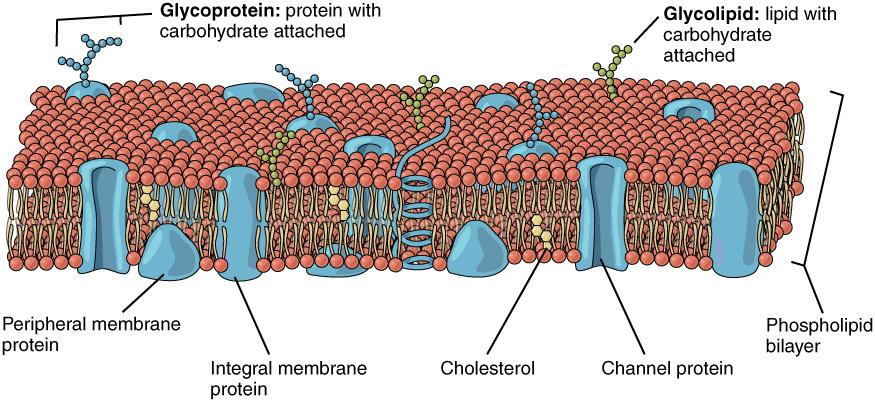
Explain ‘Fluid mosaic model’ of plasma membrane.
Answer
555k+ views
Hint: Plasma membrane is also called the cell membrane. It is the membrane found in all the cells. It separates the interior of the cell from the external environment of the cell.
Complete answer:
Fluid mosaic model of plasma membrane:
1.The fluid mosaic model of plasma membrane was proposed by the S.J. Singer and Garth L. Nicolson in 1972.
2.The fluid mosaic model of plasma membrane describes the structure of the plasma membrane.
3.The plasma membrane contain the components like phospholipids, cholesterol, proteins, and carbohydrates
4.These all components of the plasma membrane give the membrane a fluid character.
5.Plasma membrane ranges from 5 to 10 nm in thickness.
6.The proportions of the components of plasma membrane that are proteins, carbohydrates, lipids vary with the cell type.

Components of the plasma membrane:
There are the three components of the plasma membrane:
A.Phospholipids
B.Carbohydrates
C.Proteins
Phospholipids:
1. Phospholipids are the class of lipids that are present in the plasma membrane.
2. A phospholipid is a molecule which consists of glycerol, two fatty acids and one phosphate linked head group.
3. They are amphoteric in nature which means that they have a polar or hydrophilic head and a no-polar or hydrophobic tail.
4. Phospholipids arrange themselves in a manner that their hydrophobic tails facing each other and hydrophobic heads facing out.
5. There is a barrier created by this arrangement and gives a bilayer structure to the cell membrane.
Proteins:
1. The plasma membrane has integral proteins embedded in them.
2. It is the second major component of the plasma membrane.
3. These proteins are completely embedded into the membrane structure with their hydrophobic membrane regions interacting with the hydrophobic regions of the phospholipid bilayer.
Carbohydrates:
1. Carbohydrates are the third major component of the plasma membrane.
2. Carbohydrates are always found on the exterior surface of the cells where they are bound either to proteins (forming glycoproteins) or lipids (forming glycolipids).
Note: Plasma membrane is semi-permeable membrane which means that it allows the movement of selective molecules or ions across itself. Plasma membranes perform various functions like osmosis, endocytosis, exocytosis, diffusion, etc.
Complete answer:
Fluid mosaic model of plasma membrane:
1.The fluid mosaic model of plasma membrane was proposed by the S.J. Singer and Garth L. Nicolson in 1972.
2.The fluid mosaic model of plasma membrane describes the structure of the plasma membrane.
3.The plasma membrane contain the components like phospholipids, cholesterol, proteins, and carbohydrates
4.These all components of the plasma membrane give the membrane a fluid character.
5.Plasma membrane ranges from 5 to 10 nm in thickness.
6.The proportions of the components of plasma membrane that are proteins, carbohydrates, lipids vary with the cell type.

Components of the plasma membrane:
There are the three components of the plasma membrane:
A.Phospholipids
B.Carbohydrates
C.Proteins
Phospholipids:
1. Phospholipids are the class of lipids that are present in the plasma membrane.
2. A phospholipid is a molecule which consists of glycerol, two fatty acids and one phosphate linked head group.
3. They are amphoteric in nature which means that they have a polar or hydrophilic head and a no-polar or hydrophobic tail.
4. Phospholipids arrange themselves in a manner that their hydrophobic tails facing each other and hydrophobic heads facing out.
5. There is a barrier created by this arrangement and gives a bilayer structure to the cell membrane.
Proteins:
1. The plasma membrane has integral proteins embedded in them.
2. It is the second major component of the plasma membrane.
3. These proteins are completely embedded into the membrane structure with their hydrophobic membrane regions interacting with the hydrophobic regions of the phospholipid bilayer.
Carbohydrates:
1. Carbohydrates are the third major component of the plasma membrane.
2. Carbohydrates are always found on the exterior surface of the cells where they are bound either to proteins (forming glycoproteins) or lipids (forming glycolipids).
Note: Plasma membrane is semi-permeable membrane which means that it allows the movement of selective molecules or ions across itself. Plasma membranes perform various functions like osmosis, endocytosis, exocytosis, diffusion, etc.
Recently Updated Pages
Why are manures considered better than fertilizers class 11 biology CBSE

Find the coordinates of the midpoint of the line segment class 11 maths CBSE

Distinguish between static friction limiting friction class 11 physics CBSE

The Chairman of the constituent Assembly was A Jawaharlal class 11 social science CBSE

The first National Commission on Labour NCL submitted class 11 social science CBSE

Number of all subshell of n + l 7 is A 4 B 5 C 6 D class 11 chemistry CBSE

Trending doubts
Differentiate between an exothermic and an endothermic class 11 chemistry CBSE

10 examples of friction in our daily life

One Metric ton is equal to kg A 10000 B 1000 C 100 class 11 physics CBSE

Difference Between Prokaryotic Cells and Eukaryotic Cells

1 Quintal is equal to a 110 kg b 10 kg c 100kg d 1000 class 11 physics CBSE

State the laws of reflection of light




